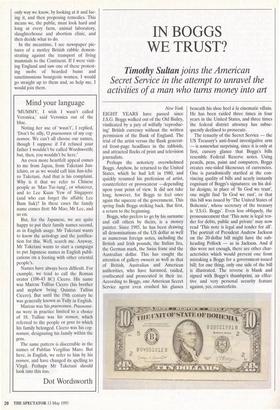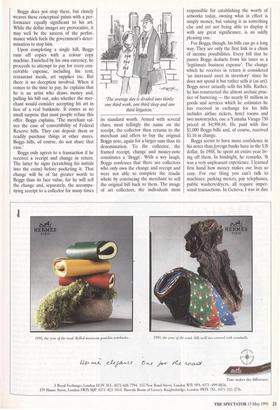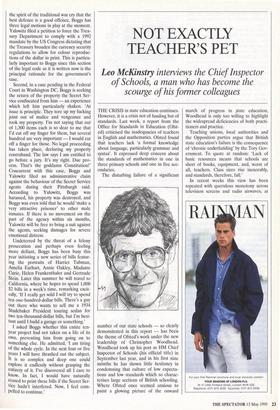IN BOGGS WE TRUST?
Timothy Sultan joins the American
Secret Service in the attempt to unravel the activities of a man who turns money into art
New York EIGHT YEARS have passed since J.S.G. Boggs walked out of the Old Bailey, vindicated by a jury of wilfully 'reproduc- ing' British currency without the written permission of the Bank of England. The trial of the artist versus the Bank generat- ed front-page headlines in the tabloids, and attracted flocks of print and television journalists.
Perhaps the notoriety overwhelmed Boggs. Anyhow, he returned to the United States, which he had left in 1980, and quickly resumed his profession of artist, counterfeiter or provocateur —depending upon your point of view. It did not take long, however, for Boggs to feel once again the squeeze of the government. This spring finds Boggs striking back. But first, a return to the beginning.
Boggs, who prefers to go by his surname and call others by theirs, is a money painter. Since 1985, he has been drawing all denominations of the US dollar as well as numerous foreign notes, including the British and Irish pounds, the Italian lira, the German mark, the Swiss franc and the Australian dollar. This has caught the attention of gallery owners as well as that of British, Australian and American authorities, who have harassed, raided, confiscated and prosecuted in their ire. According to Boggs, one American Secret Service agent even crushed his glasses beneath his shoe heel a la cinematic villain. He has been raided three times in four years in the United States, and three times the federal district attorney has subse- quently declined to prosecute.
The tenacity of the Secret Service — the US Treasury's anti-fraud investigative arm — is somewhat surprising, since it is only at first, cursory glance that Boggs's bills resemble Federal Reserve notes. Using pencils, pens, paint and computers, Boggs creates one-sided likenesses of currencies. One is paradoxically startled at the con- vincing quality of bills and nearly instantly cognisant of Boggs's signatures: on his dol- lar designs, in place of 'In God we trust', one might find 'In God we rust', or that this bill was issued by 'The United States of Bohemia', whose secretary of the treasury is `J.S.G. Boggs'. Even less obliquely, the pronouncement that 'This note is legal ten- der for debts, public and private' may now read `This note is legal and tender for all'. The portrait of President Andrew Jackson on the 20-dollar bill might have the sub- heading Pollock — as in Jackson. And if this were not enough, there are other char- acteristics which would prevent one from mistaking a Boggs for a government-issued bill; for one thing, only one side of the bill is illustrated. The reverse is blank and signed with Boggs's thumbprint, an effec- tive and very personal security feature against, yes, counterfeits. Boggs does not stop there, but closely weaves these conceptual prints with a per- formance equally significant to his art. While the dollar images are provocative, it may well be the success of the perfor- mance which fuels the government's deter- mination to stop him.
Upon completing a single bill, Boggs runs off copies with a colour copy machine. Enriched by his own currency, he proceeds to attempt to pay for every con- ceivable expense, including his rent, restaurant meals, art supplies etc. But there is no deception involved. When it comes to the time to pay, he explains that he is an artist who draws money and, pulling his bill out, asks whether the mer- chant would consider accepting his art in lieu of a real banknote. It comes as no small surprise that most people refuse this offer. Boggs explains, 'The merchant val- ues the ease of convertibility of Federal Reserve bills. They can deposit them or readily purchase things at other stores. Boggs bills, of course, do not share that ease.'
Boggs only agrees to a transaction if he receives a receipt and change in return. The latter he signs (scratching his initials into the coins) before pocketing it. That change will be of far greater worth to Boggs than its face value, for he will sell the change and, separately, the accompa- nying receipt to a collector for many times The average day is divided into thirds: one third work, one third sleep and one third litigation.'
its standard worth. Armed with several clues, most tellingly the name on the receipt, the collector then returns to the merchant and offers to buy the original Boggs note, again for a larger sum than its denomination. To the collector, the framed receipt, change and money-note constitutes a 'Boggs'. With a wry laugh, Boggs confesses that there are collectors who only own the change and receipt and were not able to complete the triadic whole by convincing the merchant to sell the original bill back to them. The image of art collectors, the individuals most responsible for establishing the worth of artworks today, owning what in effect is simply money, but valuing it as something else and yet not being able to display it with any great significance, is an oddly pleasing one.
For Boggs, though, his bills can go a long way. They are only the first link in a chain of income possibilities. Every bill that he passes Boggs deducts from his taxes as a `legitimate business expense'. The change which he receives in return is considered `an increased asset in inventory' since he does not spend it but rather sells it (as art). Boggs never actually sells his bills. Rather, he has resurrected the almost archaic prac- tice of bartering — the nearly $1 million in goods and services which he estimates he has received in exchange for his bills includes airline tickets, hotel rooms and two motorcycles, one a Yamaha Virago 750 priced at $4,998.84. He paid with five $1,000 Boggs bills and, of course, received $1.16 in change.
Boggs seems to have more confidence in his notes than4oreign banks have in the US dollar. In 1988, he spent an entire year liv- ing off them. In hindsight, he remarks, 'It was a very unpleasant experience. I learned first hand how money makes our lives so easy. For one thing you can't talk to machines: parking meters, pay telephones, public washers/dryers, all require imper- sonal transactions. In Geneva, I was in dire straits when I couldn't go to the lavatory — I didn't have the one franc. A generous person exiting from the stall held the door open.' And this may be the simple founda- tion of Boggs's endeavour — to point out the efficiency and, in his words, 'the beau- ty' of commerce. 'My subject matter is paper money. But at a deeper level it's a society's cultural approach to money how people's behaviour and thinking are reflected by the operation of these instru- ments.'
The vexing question of how value is established for art is both directly con- fronted and directly evaded by Boggs. If one has misgivings at the news of yet another glassed-in vacuum cleaner or painting produced by an artist's assistants in an assembly-line manner selling for a large sum, one might expect Boggs's bla- tant art-as-commodity (or really art-as-ten- der) to make light of the vagarious way art is valued. Clearly, an intention of his is to question why we prize one work and not another, to remind us not to confuse intrinsic value with abstract values (as rep- resented by the monetary system). He is walking a weird line between art and money. He calls his bills art since they are conceptual creations out of thought, labour and artistry, and yet he arrives at an arbitrary value for them in the same way banknotes are valued. He tells you that this bill is worth the amount shown in the corners, no more and no less. The nature of his art has assumed the nature of his subject, money.
Speaking of worth with Boggs can lead to startling sequences, and one feels as though one's own responses to his prompt- ings have already been mapped out. In a conversation over dinner on the spiritual foundation of money, the following dia- logue ensued: Boggs: Why do we value money? Faith, really. When we no longer backed dollars with precious metals, we added the phrase 'In God we trust' to our bills. Money has no intrinsic value. When the gold standard was in effect, money was directly represen- tative of a certain weight in gold. But why do we value gold?
Sultan: It is scarce, difficult to leach from rock and has a history of being prized in nearly every culture.
Boggs: All this is true, but other ele- ments have some of these characteristics but were not valued in a similar way.
Sultan: Perhaps an association with reli- gious rites?
Boggs: Exactly. Not only does gold sug- gest the emphasis that religions place on purity — gold does not tarnish — but in pre-Christian times it was actually revered for its intrinsically numinous quality. For example, a culture which worshipped the sun as its central deity would find gold in the earth, look at the sun, look back at the gold and, bingo! The resemblance was clear. It followed that if gold was part of the sun at one time and one worshipped the sun as God, then gold had divine prop- erties.
In 1991, Boggs, who did not graduate from high school, was unironically named Research Fellow in Art and Ethics at the Center for the Advancement of Applied Ethics at the prestigious Carnegie Mellon University. After thinking about money for ten years, he seemed to be perfectly matched with the institute, which is attached to the university's philosophy department and which describes itself as a centre for 'teaching people practical meth- ods for analysing and responding to real ethical problems' and exploring 'new methods and models for analysis and man- agement of complex real world conflicts'. The centre seeks out areas of controversy such as euthanasia, abortion or obscenity and creates case studies for research and educational purposes. Boggs's principal supporter, Professor Preston Covey, recognised that Boggs's work had nothing to do with fraud, that fraud was antitheti- cal to his real intention of inciting reflec- tion on the nature of money and value and on the dynamics of transactions. In Covey's view it was not problematic to appoint a potential lawbreaker to an insti- tute studying ethics, since Boggs was test- ing the law's sovereignty not from the perspective of an opportunist with person- al gain in mind, but rather as seeker after truth.
To Carl Meyer, the Secret Service agent in charge of the Boggs case, there was no dilemma either. Boggs was clearly not fol- lowing the letter of the law. 'What is unusual about Boggs is that in most other cases involving dollar-bill reproductions a J.S.G. Boggs phone call and a cease and desist order are enough, but he doesn't stop. He's a persis- tent son of a gun,' Meyer says.
While Boggs's new title may have legit- imised his work to some, it did not prevent him from being arrested and having his stu- dio and office searched. The search came on the heels of the boldest and broadest project yet. He printed 1 million Boggs dol- lars, intending to put all the monies into circulation in Pittsburgh, a middle-size city where such an infusion of alternative cur- rency could not go unnoticed. Further, he hoped to keep his bills in circulation by asking each person who successfully passed one to put their own thumbprint in one of the five circles he printed on the otherwise blank reverse side of the bill. The Secret Service responded in kind to this provoca- tion and conducted their boldest and broadest raid against Boggs. They confis- cated prints, paintings, personal diaries, a calculator, a pair of boxer shorts, match- books, a $100 bow-tie, magazine clippings and over 1,200 other possessions, labelling them 'evidence of intent'.
In a disarming manner, Meyer explains his agency's severe reaction: 'Think of it like this. It's as though the Secret Service were setting a speed trap and Boggs keeps driving by at a hundred miles per hour, and on top of that thumbs his nose at us every time.'
Three years later, these items are still being held in a continuing counterfeiting investigation against Boggs. He must find the accusation especially galling since he seems to have more venomous feelings for counterfeiters than the average person, who, he says, 'considers counterfeiting a crime against the government, not against them. This is a delusion. It is the individual person not the government who loses by accepting a fake bill.' (In fact, his own bills have been subject to dozens of counterfeit- ing attempts since they can be quite valu- able among collectors. This led him to incorporate security features akin to those the government uses, such as serial num- bers, plate numbers, inks visible only under specialised lights and magnetic devices.) With the last raid, following two prior ones at galleries in Wyoming and Florida, the government has pushed Boggs too far. Outmatched, Boggs was soon represented by Kent Yalowitz, a lawyer with Arnold and Porter, the largest law firm in Wash- ington DC. It is Boggs's good fortune that he is being represented pro bono since he has run up an estimated half a million dol- lars in legal fees. Incidentally, Abe Fortas, who later became the first US Supreme Court justice to resign as a result of alleged financial improprieties, was a founding partner of the firm. For the government, what is at issue legally is not necessarily that Boggs is producing spurious money but rather the blanket prohibition against producing a likeness of the dollar in colour, regardless of the dimensions. It is this pro- hibition which Boggs wants to overturn. In the spirit of the traditional war cry that the best defence is a good offence, Boggs has three legal motions in play at the moment. Yalowitz filed a petition to force the Trea- sury Department to comply with a 1992 mandate by the US Congress dictating that the Treasury broaden the currency security regulations to allow for colour reproduc- tions of the dollar in print. This is particu- larly important to Boggs since this section of the legal code as it is written now is the principal rationale for the government's case.
Second, in a case pending in the Federal Court in Washington DC, Boggs is seeking the return of the property the Secret Ser- vice confiscated from him — an experience which left him particularly shaken. 'At issue is principle. They tore up my fucking joint out of malice and vengeance and took my property. I'm not saying that out of 1,300 items each is so dear to me that I'd cut off my finger for them, but several hundred are very important — I would cut off a finger for those. No legal proceeding has taken place, declaring my property contraband. The law says I am entitled to go before a jury. It's my right. Due pro- cess. That's the goddamn Constitution!' Concurrent with this case, Boggs and Yalowitz filed an administrative claim against the behaviour of the Secret Service agents during their Pittsburgh raid. According to Yalowitz, Boggs was harassed, his property was destroyed, and Boggs was even told that he would 'make a very attractive prisoner' to other male inmates. If there is no movement on the part of the agency within six months, Yalowitz will be free to bring a suit against the agents, seeking damages for severe emotional distress.
Undeterred by the threat of a felony prosecution and perhaps even feeling more defiant, Boggs has been busy this year initiating a new series of bills featur- ing the portraits of Harriet Tubman, Amelia Earhart, Annie Oakley, Madame Curie, Helen Frankenthaler and Gertrude Stein. Later this summer he will travel to California, where he hopes to spend 1,000 $2 bills in a week's time, remarking excit- edly, 'If I really get wild I will try to spend ten one-hundred-dollar bills. There's a guy out there who wants to sell me a 1934 Studebaker President touring sedan for two ten-thousand-dollar bills, but I'm hesi- tant until I build a garage or something.'
I asked Boggs whether this entire ten- year project had not taken on a life of its own, preventing him from going on to something else. He admitted, 'I am tiring of the whole cycle. In the next four or five years I will have thrashed out the subject. It is so complex and deep one could explore it endlessly without grasping the entirety of it. I've discovered all I care to know. In fact, I would have naturally ceased to print these bills if the Secret Ser- vice hadn't interfered. Now, I feel com- pelled to continue.'





































































 Previous page
Previous page